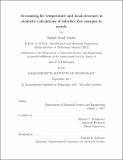| dc.contributor.advisor | Michael J. Demkowicz. | en_US |
| dc.contributor.author | Navale, Sanket Sunil | en_US |
| dc.contributor.other | Massachusetts Institute of Technology. Department of Materials Science and Engineering. | en_US |
| dc.date.accessioned | 2018-03-02T21:39:39Z | |
| dc.date.available | 2018-03-02T21:39:39Z | |
| dc.date.copyright | 2017 | en_US |
| dc.date.issued | 2017 | en_US |
| dc.identifier.uri | http://hdl.handle.net/1721.1/113929 | |
| dc.description | Thesis: Ph. D., Massachusetts Institute of Technology, Department of Materials Science and Engineering, 2017. | en_US |
| dc.description | This electronic version was submitted by the student author. The certified thesis is available in the Institute Archives and Special Collections. | en_US |
| dc.description | Cataloged from student-submitted PDF version of thesis. | en_US |
| dc.description | Includes bibliographical references (pages 175-193). | en_US |
| dc.description.abstract | Interfaces are ubiquitous in crystalline materials and they predominantly govern the properties of metals at nanoscale. Free energy is the most significant characteristic of an interface that determines its behavior and other properties. However, interfaces have an internal structure with nanoscale features that gives the interface free energy, a location dependent variation. The interface free energy is also expected to depend on temperature, especially for entropy stabilized phases such as liquids. I present methods for calculating location-dependent energies for solid-state interfaces and temperature-dependent free energies for solid/liquid interfaces using atomistic models. I demonstrate these methods on CuNbHe and AlGa models due to the importance of location- and temperature-dependence of interface energies in these systems. My analysis sheds light on interfacial He precipitation in CuNb composites and on Ga permeation through grain boundaries (GB) in Al. Based on the Gibbsian definition of excess interface energy, I develop a method to compute location dependent energy of solid/solid interface from atomic level energies and apply it to characterize four different Cu/Nb interfaces and several GBs of Al. The solid-state interface energies are indeed location-dependent and vary at the length scale of few nanometers. For any particular interface, the variation in the energies spans a range of ś100% of its average energy. The higher energy regions correspond to the underlying misfit dislocation network of the semicoherent interfaces. I compute the stress of solid/liquid interface from capillary pressure of the interface using the Young-Laplace equation and then derive its free energy. Applying this method to Cu/He and Nb/He interfaces, I find that these interface energies are dependent on He pressure and interface curvature but not explicitly on temperature. I fit analytical expressions for these interface free energies and study the impact of their curvature dependence on He cluster growth. For instance, the incorporation of curvature dependence of metal-He interface free energies accounts for a decrease of up to 1GPa in the pressure required to punch out a dislocation from the bubble into the metal. Al/Ga interface energy is found to be negative, implying that Ga can spread on all Al surfaces and GBs. The computed interface energies may be used to predict the distribution of He precipitates at CuNb interfaces while interface energies for AlGa shed light on the crystallographic character-dependence of Ga permeation through Al GBs. These results may be directly incorporated into phase field models of He behavior in CuNb composites and Ga behavior at Al GBs. | en_US |
| dc.description.statementofresponsibility | by Sanket Sunil Navale. | en_US |
| dc.format.extent | 193 pages | en_US |
| dc.language.iso | eng | en_US |
| dc.publisher | Massachusetts Institute of Technology | en_US |
| dc.rights | MIT theses are protected by copyright. They may be viewed, downloaded, or printed from this source but further reproduction or distribution in any format is prohibited without written permission. | en_US |
| dc.rights.uri | http://dspace.mit.edu/handle/1721.1/7582 | en_US |
| dc.subject | Materials Science and Engineering. | en_US |
| dc.title | Accounting for temperature and local structure in atomistic calculations of interface free energies in metals | en_US |
| dc.type | Thesis | en_US |
| dc.description.degree | Ph. D. | en_US |
| dc.contributor.department | Massachusetts Institute of Technology. Department of Materials Science and Engineering | |
| dc.identifier.oclc | 1023630301 | en_US |
